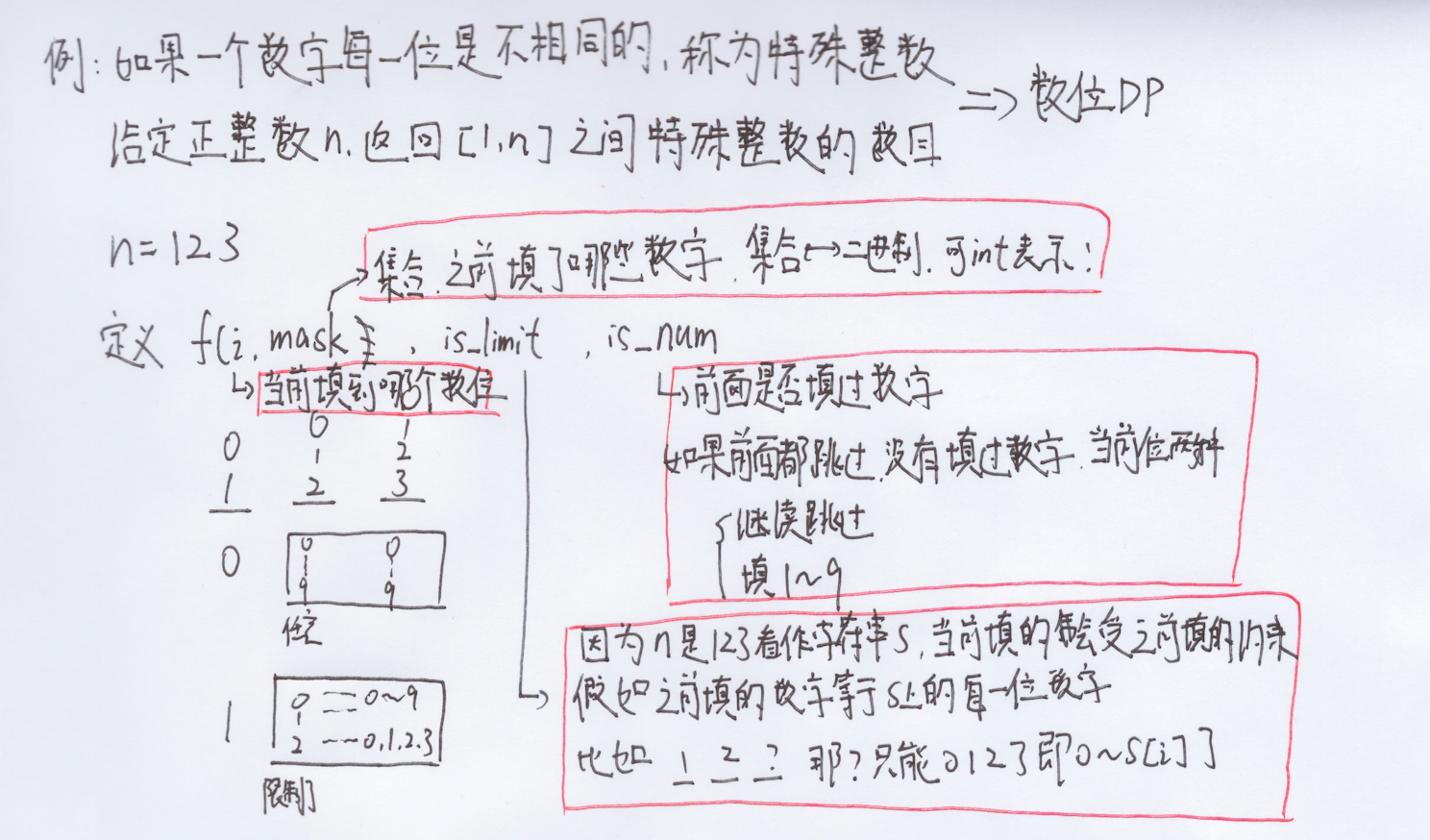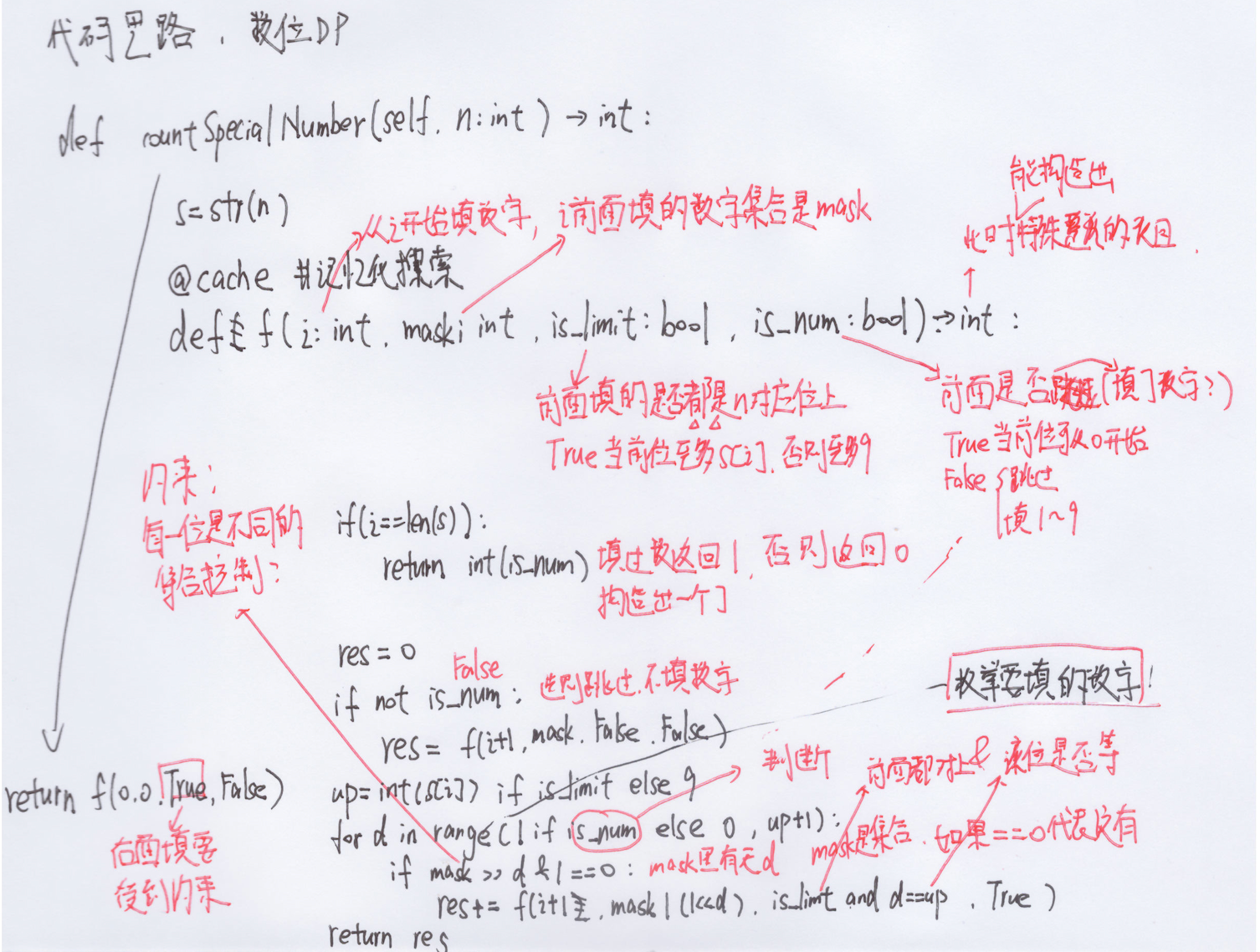数位dp:记忆化搜索中可以带着数字和bool!
1. 题目特点描述 + 例题:LeetCode 2376. 统计特殊整数
题目特点描述:这种题目是非常非常经典能一眼看出来的,统计1~n或者num1~num2区间内,所有满足某种条件整数的个数。而且题目数值范围给的区间会非常大,可能会到10^9这种级别的数据量
经典题目描述示例:如果一个正整数每一个数位都是互不相同的,我们称它是特殊整数。给一个正整数n,返回区间[1,n]之间特殊整数的数目。例如1 2 3 4 5 6 7 8 9 10 11 12 13 14 15 16 17 18 19 20,这其中只有11不是特殊整数,所以返回19


1
2
3
4
5
6
7
8
9
10
11
12
13
14
15
16
17
18
19
20
21
22
23
24
25
26
27
28
|
class Solution:
def countSpecialNumbers(self, n: int) -> int:
s = str(n)
@cache
def f(i: int, mask: int, is_limit: bool, is_num: bool) -> int:
if i == len(s):
return int(is_num)
res = 0
if not is_num:
res = f(i+1, mask, False, False)
up = int(s[i]) if is_limit else 9
for d in range(0 if is_num else 1, up+1):
if mask >> d & 1 == 0:
res += f(i+1, mask|(1<<d), is_limit and d == up, True)
return res
return f(0, 0, True, False)
|
2. 灵活变通,LeetCode 902. 最大为N的数字组合
2.1 题目大意&思路
https://leetcode.cn/problems/numbers-at-most-n-given-digit-set/
给定一个按 非递减顺序 排列的数字数组 digits 。你可以用任意次数 digits[i] 来写的数字。例如,如果 digits = ['1','3','5'],我们可以写数字,如 '13', '551', 和 '1351315'。
返回 可以生成的小于或等于给定整数 n 的正整数的个数
思路:按照上面的模板套一下,因为不需要每个数字都不一样了,所以不需要mask了。在下面for循环取数的时候,直接for in digits这里面的数字,然后超过up就break掉。这个地方注意题目给的是字符串,需要根据字符串来魔改一下
1
2
3
4
5
6
7
8
9
10
11
12
13
14
15
16
17
18
19
20
21
22
23
24
25
26
27
28
| class Solution:
def atMostNGivenDigitSet(self, digits: List[str], n: int) -> int:
s = str(n)
@cache
def f(i: int, mask: int, is_limit: bool, is_num: bool) -> int:
if i == len(s):
return int(is_num)
res = 0
if not is_num:
res = f(i+1, None, False, False)
up = int(s[i]) if is_limit else 9
for d in range(0 if is_num else 1, up+1):
if str(d) in digits:
res += f(i+1, None, is_limit and d == up, True)
else:
continue
return res
return f(0, None, True, False)
|
3. LeetCode 2719. 统计整数数目
3.1 题目大意
https://leetcode.cn/problems/count-of-integers/
给你两个数字字符串 num1 和 num2 ,以及两个整数 max_sum 和 min_sum 。如果一个整数 x 满足以下条件,我们称它是一个好整数:
请你返回好整数的数目。答案可能很大,请返回答案对 10^9 + 7 取余后的结果。
注意,digit_sum(x) 表示 x各位数字之和。
示例1:
1
2
3
| 输入:num1 = "1", num2 = "12", min_num = 1, max_num = 8
输出:11
解释:总共有 11 个整数的数位和在 1 到 8 之间,分别是 1,2,3,4,5,6,7,8,10,11 和 12 。所以我们返回 11 。
|
示例2:
1
2
3
| 输入:num1 = "1", num2 = "5", min_num = 1, max_num = 5
输出:5
解释:数位和在 1 到 5 之间的 5 个整数分别为 1,2,3,4 和 5 。所以我们返回 5 。
|
提示:
1 <= num1 <= num2 <= 10^221 <= min_sum <= max_sum <= 400
3.2 分析和解答
先简单转化一下,f(num2)-f(num1),这个在数位dp里面是很简单的思路了
在本身的基础上需要把sum这个作为一个dfs的参数,这里扩展一下变成dfs(i, mask, is_limit, is_num, sum),其中mask(填了哪些数字),is_num(前面是否填过数字了,有些情况比如012 和120这个0就要重复判断这样的),mask和is_num这两个参数就不需要
然后这个题在dfs基础上要把sum作为一个参数,这个值来在递归终点i==len(nums)的时候控制是否符合条件
还有一个操作就是这个题给的num1不一定是符合条件的,反正就是注意把边界也判断一下,这种题目确实比较ACM如果搞不对就不好debug了
1
2
3
4
5
6
7
8
9
10
11
12
13
14
15
16
17
18
| class Solution:
def count(self, num1: str, num2: str, min_sum: int, max_sum: int) -> int:
MOD = 10 ** 9 + 7
def f(s: string) -> int:
@cache
def f(i: int, sum: int, is_limit: bool) -> int:
if sum > max_sum:
return 0
if i == len(s):
return int(sum >= min_sum)
res = 0
up = int(s[i]) if is_limit else 9
for d in range(up + 1):
res += f(i + 1, sum + d, is_limit and d == up)
return res % MOD
return f(0, 0, True)
ans = f(num2) - f(num1) + (min_sum <= sum(map(int, num1)) <= max_sum)
return ans % MOD
|
4. 简单同步一下0x3F题单,几个题简单解释一下
4.1 LeetCode 233. 数字1的个数
https://leetcode.cn/problems/number-of-digit-one/
给定一个整数 n,计算所有小于等于 n 的非负整数中数字 1 出现的个数。
示例1:
示例2:
提示
分析和解答:这里就是把一个数字中1出现的次数作为累加值,起到类似sum的作用
1
2
3
4
5
6
7
8
9
10
11
12
13
14
15
16
17
18
19
20
21
22
23
24
25
26
27
28
| class Solution:
def countDigitOne(self, n: int) -> int:
s = str(n)
@cache
def f(i: int, mask: int, is_limit: bool, is_num: bool, cnt1: int) -> int:
if i == len(s):
return cnt1
res = 0
if not is_num:
res = f(i+1, None, False, False, cnt1)
up = int(s[i]) if is_limit else 9
for d in range(0 if is_num else 1, up+1):
if d == 1:
res += f(i+1, None, is_limit and d == up, True, cnt1+1)
else:
res += f(i+1, None, is_limit and d == up, True, cnt1)
return res
return f(0, None, True, False, 0)
|
4.2 LeetCode 面试题 17.06. 2出现的次数
https://leetcode.cn/problems/number-of-2s-in-range-lcci/
编写一个方法,计算从 0 到 n (含 n) 中数字 2 出现的次数。
示例:
1
2
3
| 输入: 25
输出: 9
解释: (2, 12, 20, 21, 22, 23, 24, 25)(注意 22 应该算作两次)
|
提示:
4.3 LeetCode 600. 不含连续1的非负整数
https://leetcode.cn/problems/non-negative-integers-without-consecutive-ones/
给定一个正整数 n ,请你统计在 [0, n] 范围的非负整数中,有多少个整数的二进制表示中不存在 连续的 1 。
示例1:
1
2
3
4
5
6
7
8
9
10
11
| 输入: n = 5
输出: 5
解释:
下面列出范围在 [0, 5] 的非负整数与其对应的二进制表示:
0 : 0
1 : 1
2 : 10
3 : 11
4 : 100
5 : 101
其中,只有整数 3 违反规则(有两个连续的 1 ),其他 5 个满足规则。
|
示例2:
示例3:
提示:
分析和解答
1
2
3
4
5
6
7
8
9
10
11
12
13
| class Solution:
def findIntegers(self, n: int) -> int:
s = str(bin(n))[2:]
@cache
def f(i: int, pre1: bool, is_limit: bool) -> int:
if i == len(s):
return 1
up = int(s[i]) if is_limit else 1
res = f(i + 1, False, is_limit and up == 0)
if not pre1 and up == 1:
res += f(i + 1, True, is_limit)
return res
return f(0, False, True)
|

